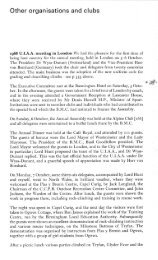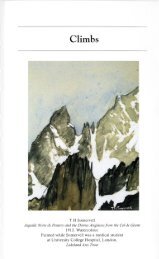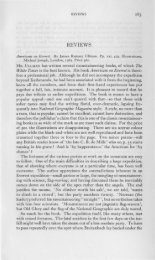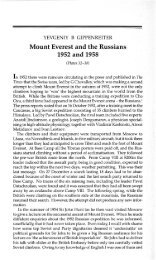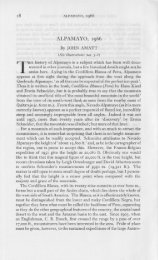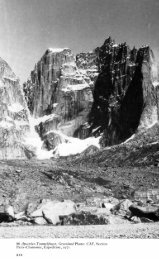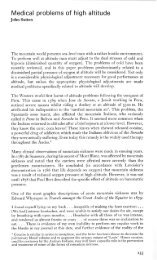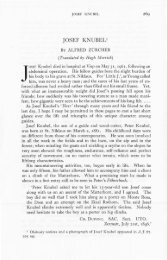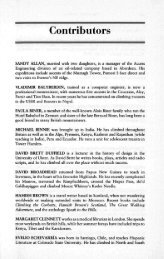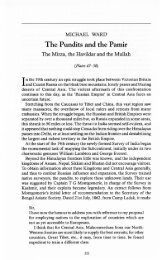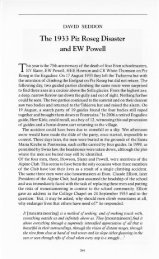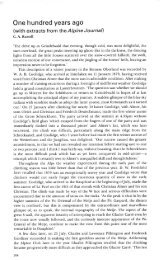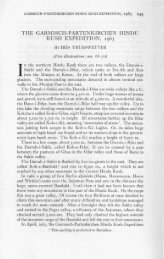History - Alpine Journal
History - Alpine Journal
History - Alpine Journal
You also want an ePaper? Increase the reach of your titles
YUMPU automatically turns print PDFs into web optimized ePapers that Google loves.
216<br />
THE ALPINE JOURNAL 2006<br />
when Lobenhoffer and Harrer jumped from the back of a moving truck.<br />
They were immediately detected and recaptured.<br />
Deolali was unbearably hot with dusty, poor accommodation, so all went<br />
on hunger strike. Internee No. 1775 Rolf Magener, interviewed in 1999,<br />
related how an investigating senior British officer walked into a melee of<br />
prisoners by now intent on murder and asked 'Gentlemen, whatever is the<br />
matter?' His self-assured behaviour saved his life. Consequently, the<br />
authorities directed an interned architect to design a purpose-built camp<br />
with all facilities at Premnagar, Dehra Dun, Mussoorie, 120 miles from the<br />
Tibetan border.<br />
The journey from Deolali to Dehra Dun provided another escape<br />
opportunity. According to the archives: 'On the evening of 10 October 1941<br />
a train conveying internees...halted for two hours at Delhi. It was discovered<br />
that Lobenhoffer, internee No. 1085, was missing. He was re-arrested at<br />
Puri, Orissa, 13 October. The arrangements by the Military escort for the<br />
safe custody of these internees appear to have left much to be desired.'<br />
Later, he claimed to be an army officer, which in fact he was. He had been<br />
commissioned on 1 January 1938 as a lieutenant in the 100th Mountain<br />
Chaser Regiment and had been detailed to accompany the expedition.<br />
However, the archives state: 'There is nothing in our papers to show that<br />
Lobenhoffer was, as now claimed, detailed by the German High Command<br />
to accompany the Expedition.' He persuaded the British to treat him as an<br />
'Officer Prisoner of War' and he was transferred to Canada, where he<br />
pretended to be mad and was repatriated under a prisoner exchange scheme.<br />
Harrer, still determined to escape, had few resources, so one night he<br />
crept to the Italian sector to meet General Marchese who could finance<br />
escapes but needed an experienced Himalayan fellow traveller. In 1999,<br />
Magener related that Marchese had visions of ultimately making a triumphal<br />
return march down the Via Del Corso in Rome. Escaping by night in June<br />
1943, they put a ladder over a sentry-post; as they ran off, the alarm was<br />
raised. A sentry grabbed the ladder from the assisting Magener and threw<br />
it away - and an incredulous Magener simply walked back unpunished to<br />
his hut. After 18 days, Harrer and Marchese were confronted and arrested<br />
by an Indian, the multi-lingual Chief Forester of Tehri-Garhwal. Shortly<br />
afterwards, they were amazed to be joined by Aufschnaiter and Father Carl<br />
Calenberg, a Jesuit priest, who had escaped six days later. Back in Dehra<br />
Dun, Camp Commandant Colonel Williams received them with: 'You made<br />
a daring escape. I am sorry, I have to give you 28 days.'<br />
By now, five others as well as Harrer and Aufschnaiter had also plotted<br />
to escape, including fluent English speakers Magener and Heins von Have.<br />
Magener had been interned in Bombay; von Have in Dutch Indonesia,<br />
from where he, with 1320 other civilians, was sent to India in 1941 after<br />
Japan entered the war, in three crowded, unmarked ships; his was sunk by<br />
the Japanese with the loss of 500 lives. After landing in Bombay, he escaped<br />
with Hans-Peter Hulsen by jumping from a moving train. They were soon



